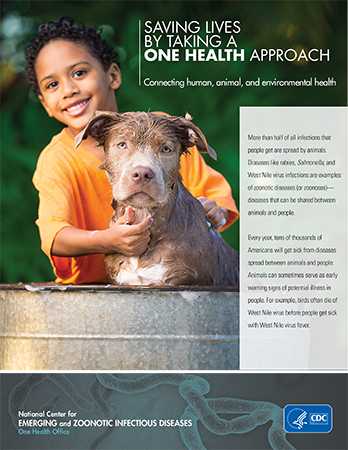One Health Basics
The One Health concept recognizes that the health of people is connected to the health of animals and the environment. CDC uses a One Health approach by working with physicians, veterinarians, ecologists, and many others to monitor and control public health threats and to learn about how diseases spread among people, animals, and the environment.
One Health is defined as a collaborative, multisectoral, and trans-disciplinary approach — working at the local, regional, national, and global levels — with the goal of achieving optimal health outcomes recognizing the interconnection between people, animals, plants, and their shared environment.
There are many examples that show how the health of people is related to the health of animals and the environment. For instance, some diseases can be shared between animals and people. These diseases are known as zoonotic diseases. Examples include:

Animals also share our susceptibility to some diseases and environmental hazards. Because of this, they can serve as early warning signs of potential human illness. For example, birds often die of West Nile virus before people get sick with West Nile virus fever.
One Health is not a new concept, but it has become more important in recent years. This is because many factors have changed interactions between people, animals, and our environment. These changes have led to the emergence and reemergence of many diseases.
Successful public health interventions require the cooperation of human, animal, and environmental health communities. By promoting this collaboration, CDC achieves optimal health outcomes for both people and animals.
| Factor (Cause) | Change (Effect) |
|---|---|
| Human populations are growing and expanding into new geographic areas. | As a result, more people live in close contact with wild and domestic animals. Close contact provides more opportunities for diseases to pass between animals and people. |
| The earth has experienced changes in climate and land use, such as deforestation and intensive farming practices. | Disruptions in environmental conditions and habitats provide new opportunities for diseases to pass to animals. |
| International travel and trade have increased. | As a result, diseases can spread quickly across the globe. |
- Page last reviewed: July 14, 2017
- Page last updated: August 4, 2017
- Content source:


 ShareCompartir
ShareCompartir
